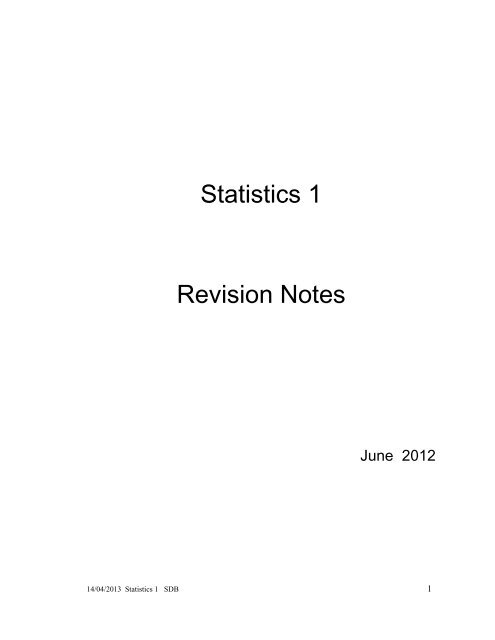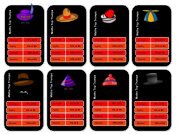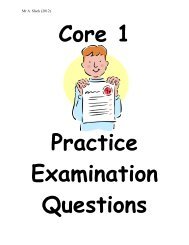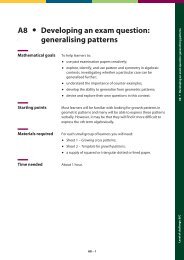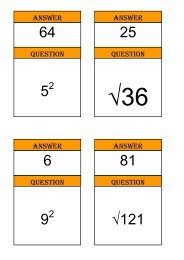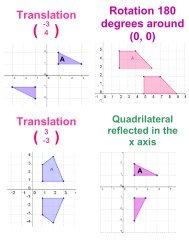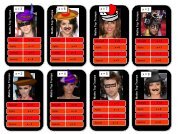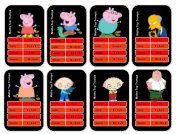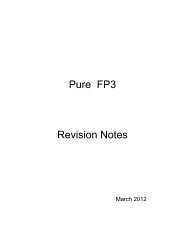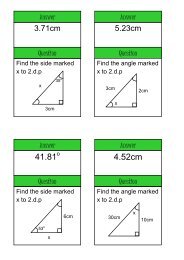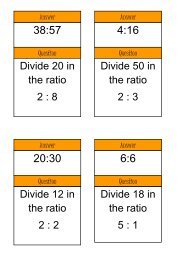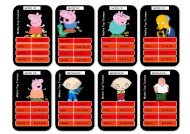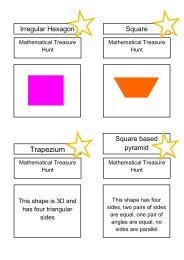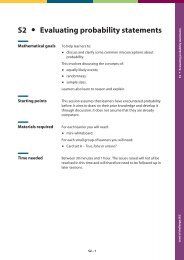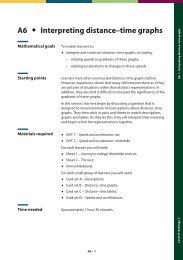Statistics 1 Revision Notes - Mr Barton Maths
Statistics 1 Revision Notes - Mr Barton Maths
Statistics 1 Revision Notes - Mr Barton Maths
You also want an ePaper? Increase the reach of your titles
YUMPU automatically turns print PDFs into web optimized ePapers that Google loves.
<strong>Statistics</strong> 1<br />
<strong>Revision</strong> <strong>Notes</strong><br />
June 2012<br />
14/04/2013 <strong>Statistics</strong> 1 SDB 1
Contents<br />
1 Statistical modelling 6<br />
Statistical modelling ............................................................................................................ 6<br />
Definition ........................................................................................................................................................ 6<br />
Advantages ..................................................................................................................................................... 6<br />
Disadvantages ................................................................................................................................................. 6<br />
2 Representation of sample data 7<br />
Variables ............................................................................................................................. 7<br />
Qualitative variables....................................................................................................................................... 7<br />
Quantitative variables .................................................................................................................................... 7<br />
Continuous variables ...................................................................................................................................... 7<br />
Discrete variables ........................................................................................................................................... 7<br />
Frequency distributions ....................................................................................................... 7<br />
Frequency tables ............................................................................................................................................. 7<br />
Cumulative frequency .................................................................................................................................... 7<br />
Stem and leaf & back-to-back stem and leaf diagrams ....................................................... 8<br />
Comparing two distributions from a back to back stem and leaf diagram. .................................................. 8<br />
Grouped frequency distributions ......................................................................................... 8<br />
Class boundaries and widths .......................................................................................................................... 8<br />
Cumulative frequency curves for grouped data .................................................................. 9<br />
Histograms .......................................................................................................................... 9<br />
3 Mode, mean (and median) 11<br />
Mode ................................................................................................................................. 11<br />
Mean ................................................................................................................................. 11<br />
Coding ............................................................................................................................... 12<br />
Coding and calculating the mean ................................................................................................................. 12<br />
Median .............................................................................................................................. 13<br />
When to use mode, median and mean .............................................................................. 13<br />
Mode ............................................................................................................................................................. 13<br />
Median .......................................................................................................................................................... 13<br />
Mean ............................................................................................................................................................. 13<br />
2 14/04/2013 <strong>Statistics</strong> 1 SDB
4 Median (Q 2 ), quartiles (Q 1 , Q 3 ) and percentiles 14<br />
Discrete lists and discrete frequency tables ...................................................................... 14<br />
Interquartile range ........................................................................................................................................ 14<br />
Discrete lists ................................................................................................................................................. 14<br />
Discrete frequency tables ............................................................................................................................. 14<br />
Grouped frequency tables, continuous and discrete data .................................................. 15<br />
Grouped frequency tables, continuous data ................................................................................................. 15<br />
Grouped frequency tables, discrete data ...................................................................................................... 16<br />
Percentiles ..................................................................................................................................................... 17<br />
Box Plots ........................................................................................................................... 17<br />
Outliers ............................................................................................................................. 17<br />
Skewness ........................................................................................................................... 18<br />
Positive skew ................................................................................................................................................ 18<br />
Negative skew .............................................................................................................................................. 19<br />
5 Measures of spread 20<br />
Range & interquartile range .............................................................................................. 20<br />
Range ............................................................................................................................................................ 20<br />
Interquartile range ........................................................................................................................................ 20<br />
Variance and standard deviation ....................................................................................... 20<br />
Proof of the alternative formula for variance .............................................................................................. 20<br />
Rough checks, m ± s, m ± 2s ..................................................................................................................... 21<br />
Coding and variance ..................................................................................................................................... 21<br />
6 Probability 23<br />
Relative frequency ............................................................................................................ 23<br />
Sample spaces, events and equally likely outcomes ......................................................... 23<br />
Probability rules and Venn diagrams ................................................................................ 23<br />
Diagrams for two dice etc. ................................................................................................ 24<br />
Tree diagrams ................................................................................................................... 25<br />
Independent events ........................................................................................................... 26<br />
To prove that A and B are independent ..................................................................................................... 26<br />
Exclusive events ............................................................................................................... 27<br />
Number of arrangements .................................................................................................. 27<br />
14/04/2013 <strong>Statistics</strong> 1 SDB 3
7 Correlation 28<br />
Scatter diagrams ................................................................................................................ 28<br />
Positive, negative, no correlation & line of best fit. .................................................................................... 28<br />
Product moment correlation coefficient, PMCC ............................................................. 28<br />
Formulae ....................................................................................................................................................... 28<br />
Coding and the PMCC ................................................................................................................................. 29<br />
Interpretation of the PMCC ......................................................................................................................... 30<br />
8 Regression 31<br />
Explanatory and response variables .................................................................................. 31<br />
Regression line .................................................................................................................. 31<br />
Least squares regression line ....................................................................................................................... 31<br />
Interpretation ................................................................................................................................................ 32<br />
9 Discrete Random Variables 33<br />
Random Variables ............................................................................................................. 33<br />
Continuous and discrete random variables ....................................................................... 33<br />
Continuous random variables ...................................................................................................................... 33<br />
Discrete random variables ............................................................................................................................ 33<br />
Probability distributions .................................................................................................... 33<br />
Cumulative probability distribution .................................................................................. 34<br />
Expectation or expected values ......................................................................................... 34<br />
Expected mean or expected value of X. ....................................................................................................... 34<br />
Expected value of a function ........................................................................................................................ 34<br />
Expected variance ........................................................................................................................................ 34<br />
Expectation algebra ...................................................................................................................................... 35<br />
The discrete uniform distribution ...................................................................................... 36<br />
Conditions for a discrete uniform distribution ............................................................................................ 36<br />
Expected mean and variance ........................................................................................................................ 36<br />
Non-standard uniform distribution .............................................................................................................. 37<br />
10 The Normal Distribution N(μ, σ 2 ) 38<br />
The standard normal distribution N(0, 1 2 ) ...................................................................... 38<br />
The general normal distribution N(μ, σ 2 ) ....................................................................... 39<br />
Use of tables ................................................................................................................................................. 39<br />
4 14/04/2013 <strong>Statistics</strong> 1 SDB
11 Context questions and answers 42<br />
Accuracy ........................................................................................................................... 42<br />
Statistical models .............................................................................................................. 42<br />
Histograms ........................................................................................................................ 43<br />
Averages ........................................................................................................................... 43<br />
Skewness ........................................................................................................................... 44<br />
Correlation ........................................................................................................................ 45<br />
Regression ......................................................................................................................... 46<br />
Discrete uniform distribution ............................................................................................ 47<br />
Normal distribution ........................................................................................................... 47<br />
12 Appendix 49<br />
–1 ≤ P.M.C.C. ≤ 1 ........................................................................................................... 49<br />
Cauchy-Schwartz inequality ........................................................................................................................ 49<br />
P.M.C.C. between –1 and +1 ....................................................................................................................... 49<br />
Regression line and coding ............................................................................................... 50<br />
Proof ............................................................................................................................................................. 50<br />
Normal Distribution, Z = ......................................................................................... 51<br />
<br />
14/04/2013 <strong>Statistics</strong> 1 SDB 5
1 Statistical modelling<br />
Statistical modelling<br />
Example: When a die is rolled, we say that the probability of each number is . This is a<br />
<br />
statistical model, but the assumption that each face is equally likely might not be true.<br />
Suppose the die is weighted to increase the chance of a six. We might then find, after<br />
experimenting, that the probability of a six is <br />
and the probability of a one is , with the<br />
<br />
probability of other faces remaining at . In this case we have refined, or improved, the<br />
<br />
model to give a truer picture.<br />
Example: The heights of a large group of adults are measured. The mean is 172⋅3 cm and the<br />
standard deviation is 12⋅4 cm.<br />
It is thought that the general shape of the histogram can be modelled by the curve<br />
f (x) =<br />
<br />
·√ ·<br />
Definition<br />
This might not give a true picture, in which case we would have to change the equation, or<br />
refine the model.<br />
A statistical model is a simplification of a real world situation. It can be used to make<br />
predictions about a real world problem. By analysing and refining the model an improved<br />
understanding may be obtained.<br />
Advantages<br />
• the model is quick and easy to produce<br />
• the model helps our understanding of the real world problem<br />
• the model helps us to make predictions<br />
• the model helps us to control a situation – e.g. railway timetables, air traffic control etc.<br />
Disadvantages<br />
• the model simplifies the situation and only describes a part of the real world problem.<br />
• the model may only work in certain situations, or for a particular range of values.<br />
6 14/04/2013 <strong>Statistics</strong> 1 SDB
2 Representation of sample data<br />
Variables<br />
Qualitative variables<br />
Non-numerical - e.g. red, blue or long, short etc.<br />
Quantitative variables<br />
Numerical - e.g. length, age, time, number of coins in pocket, etc<br />
Continuous variables<br />
Can take any value within a given range - e.g. height, time, age etc.<br />
Discrete variables<br />
Can only take certain values - e.g. shoe size, cost in £ and p, number of coins.<br />
Frequency distributions<br />
Frequency tables<br />
A list of discrete values and their frequencies.<br />
Example: The number of M&M s is counted in several bags, and recorded in the frequency<br />
table below:<br />
number of M&M s 37 38 39 40 41 42 43<br />
frequency 3 8 11 19 13 7 2<br />
Cumulative frequency<br />
Add up the frequencies as you go down the list<br />
number of M&M s 37 38 39 40 41 42 43<br />
frequency 3 8 11 19 13 7 2<br />
cumulative frequency 3 11 22 41 54 61 63<br />
14/04/2013 <strong>Statistics</strong> 1 SDB 7
Stem and leaf & back-to-back stem and leaf diagrams<br />
Line up the digits on the leaves so that it looks like a bar chart.<br />
Add a key; e.g. 5|2 means 52, or 4|3 means 4⋅3 etc.<br />
Comparing two distributions from a back to back stem and leaf diagram.<br />
A B 8/1 = 81<br />
8 1 2 2 4 5 6 7 8<br />
3 1 0 7 2 3 5 6 7 7 8 8 9 9 9<br />
3 2 2 1 1 6 1 3 4 5 5 6 6 7 8 8 8 9 9<br />
7 6 5 5 3 3 5 0 0 1 2 3 4 5 6 8<br />
9 8 7 4 3 0 0 4<br />
8 7 5 3 1 1 3<br />
9 9 7 4 2 2<br />
5 4 3 2 1 1<br />
8 7 0<br />
1. The values in A are on average smaller than those in B<br />
2. The values in A are more spread out than those in B.<br />
Grouped frequency distributions<br />
Class boundaries and widths<br />
When deciding class boundaries you must not leave a gap between one class and<br />
another, whether dealing with continuous or discrete distributions.<br />
For discrete distributions avoid leaving gaps between classes by using class boundaries as<br />
shown below:<br />
X 0, 1, 2, 3, 4, 5, 6, 7, …<br />
Class<br />
interval – as given<br />
Class<br />
contains<br />
Class boundaries<br />
without gaps<br />
0 – 4 0, 1, 2, 3, 4 0 – 4 <br />
5 – 9 5, 6, 7, 8, 9 4 – 9 <br />
10 – 12 10, 11, 12 9 – 12 <br />
etc<br />
For continuous distributions the class boundaries can be anywhere.<br />
8 14/04/2013 <strong>Statistics</strong> 1 SDB
Cumulative frequency curves for grouped data<br />
class class<br />
cumulative<br />
frequency class<br />
interval boundaries<br />
frequency<br />
0 - 4 0 to 4 ½ 27 ≤ 4 ½ 27<br />
5 – 9 4 ½ to 9 ½ 36 ≤ 9 ½ 63<br />
10 – 19 9 ½ to 19 ½ 54 ≤ 19 ½ 117<br />
20 – 29 19 ½ to 29 ½ 49 ≤ 29 ½ 166<br />
30 – 59 29 ½ to 59 ½ 24 ≤ 59 ½ 190<br />
60 –99 59 ½ to 99 ½ 10 ≤ 99 ½ 200<br />
Plot points at ends of intervals, (4 , 27), (9 , 63), (19 , 117) etc. and join points with a<br />
<br />
smooth curve.<br />
Histograms<br />
Plot the axes with a continuous scale as normal graphs.<br />
There are no gaps between the bars of a histogram.<br />
Area equals frequency.<br />
Note that the total area under a frequency histogram is N, the total number<br />
and the area from a to b is the number of items between a and b.<br />
To draw a histogram, first draw up a table showing the class intervals, class boundaries, class<br />
widths, frequencies and then heights = – as shown below:<br />
<br />
class<br />
interval<br />
class<br />
boundaries<br />
class<br />
width<br />
frequency<br />
height<br />
0 - 4 0 to 4 <br />
4 <br />
27 6<br />
5 – 9 4 to 9 <br />
10 – 19 9 to 19 <br />
20 – 29 19 to 29 <br />
30 – 59 29 to 59 <br />
5 36 7⋅2<br />
10 54 5⋅4<br />
10 49 4⋅9<br />
30 24 0⋅8<br />
14/04/2013 <strong>Statistics</strong> 1 SDB 9
60 –99 59 to 99 <br />
40 10 0⋅25<br />
Example: A grouped frequency table for the weights of adults has the following entries:<br />
weight kg … … 50 – 60 … 70 – 85 …<br />
frequency … … 60 … 20 …<br />
In a histogram, the bar for the class 50 – 60 kg is 2 cm wide and 9 cm high.<br />
Find the width and height of the bar for the 70 – 85 kg class.<br />
Solution: 50 – 60 is usually taken to mean 50 ≤ weight < 60<br />
⇒<br />
⇒<br />
⇒<br />
The width of the 50 – 60 class is 10 kg ≡ 2 cm<br />
width of the 70 – 85 class is 15 kg ≡ <br />
× 2 = 3 cm<br />
The area of the 50 – 60 bar is 2 × 9 = 18 cm 2 ≡ frequency 60<br />
the frequency of the 70 – 85 bar is 20 ≡ an area of × 18 = 6 cm2<br />
<br />
the height of the 70 – 85 bar is area ÷ width = 6 ÷ 3 = 2 cm.<br />
Answer width of 70 – 85 kg bar is 3 cm, and height is 2 cm.<br />
10 14/04/2013 <strong>Statistics</strong> 1 SDB
3 Mode, mean (and median)<br />
Mode<br />
The mode is the value, or class interval, which occurs most often.<br />
Mean<br />
The mean of the values x 1 , x 2 , … , x n with frequencies f 1 , f 2 , … , f n the mean is<br />
<br />
<br />
1 , where <br />
<br />
<br />
Example: Find the mean for the following table showing the number of children per family.<br />
Solution: Number of children Frequency<br />
x f xf<br />
0 5 0<br />
1 8 8<br />
2 12 24<br />
3 18 54<br />
4 9 36<br />
5 4 20<br />
56 142<br />
Σ x i f i = 142, and N = Σ f i = 56<br />
⇒ = <br />
<br />
= 2⋅54 to 3 S.F.<br />
14/04/2013 <strong>Statistics</strong> 1 SDB 11
In a grouped frequency table you must use the mid-interval value.<br />
Example: The table shows the numbers of children in prep school classes in a town.<br />
Solution: Number Mid-interval Frequency<br />
of children value<br />
x f xf<br />
1 - 10 5⋅5 5 27⋅5<br />
11 - 15 13 8 104<br />
16 – 20 18 12 216<br />
21 - 30 25⋅5 18 459<br />
31 - 40 35⋅5 11 390⋅5<br />
54 1197<br />
Σ x i f i = 1197, and N = Σ f i = 54<br />
⇒ = <br />
= 22⋅2 to 3 S.F.<br />
<br />
Coding<br />
The weights of a group of people are given as x 1 , x 2 , … x n in kilograms. These weights are<br />
now changed to grammes and given as t 1 , t 2 , … t n .<br />
In this case t i = 1000 × x i – this is an example of coding.<br />
Another example of coding could be t i = 20<br />
.<br />
<br />
Coding and calculating the mean<br />
With the coding, t i = 20<br />
, we are subtracting 20 from each x-value and then dividing the<br />
<br />
result by 5.<br />
We first find the mean for t i , and then we reverse the process to find the mean for x i<br />
⇒ we find the mean for t i , multiply by 5 and add 20, giving = 5 + 20<br />
Proof:<br />
t i = 20<br />
<br />
<br />
1 <br />
<br />
<br />
⇒ x i = 5t i + 20<br />
<br />
1<br />
5 20 <br />
<br />
5 20<br />
<br />
<br />
<br />
<br />
12 14/04/2013 <strong>Statistics</strong> 1 SDB
5 20 since 1 and <br />
<br />
<br />
Example: Use the coding t i = 165<br />
to find the mean weight for the following<br />
<br />
distribution.<br />
Weight, kg Mid-interval Coded value Frequency<br />
x i t i = 165<br />
f i<br />
<br />
140 - 150 145 –2 9 –18<br />
150 - 160 155 –1 21 –21<br />
160 - 170 165 0 37 0<br />
170 - 180 175 1 28 28<br />
180 - 190 185 2 11 22<br />
106 11<br />
t i f i<br />
⇒<br />
and<br />
⇒<br />
= <br />
<br />
t i = 165<br />
<br />
⇒ = 10 + 165 = 10 × <br />
mean weight is 166⋅04 kg to 2 D.P.<br />
<br />
+ 165 = 166⋅0377358<br />
Here the coding simplified the arithmetic<br />
for those who like to work without a calculator!<br />
Median<br />
The median is the middle number in an ordered list. Finding the median is explained in the<br />
next section.<br />
When to use mode, median and mean<br />
Mode<br />
You should use the mode if the data is qualitative (colour etc.) or if quantitative (numbers)<br />
with a clearly defined mode (or bi-modal). It is not much use if the distribution is fairly even.<br />
Median<br />
You should use this for quantitative data (numbers), particularly when there are extreme values<br />
(outliers).<br />
Mean<br />
This is for quantitative data (numbers), and uses all pieces of data. It gives a true measure, but<br />
is affected by extreme values (outliers).<br />
14/04/2013 <strong>Statistics</strong> 1 SDB 13
4 Median (Q 2 ), quartiles (Q 1 , Q 3 ) and percentiles<br />
Discrete lists and discrete frequency tables<br />
To find medians and quartiles<br />
1. Find k = (for Q 2), (for Q 1), (for Q 3).<br />
2. If k is an integer, use the mean of the k th and (k + 1) th numbers in the list.<br />
3. If k is not an integer, use the next integer up, and find the number with that position in<br />
the list.<br />
Interquartile range<br />
The interquartile range, I.Q.R., is Q 3 – Q 1 .<br />
Discrete lists<br />
A discrete list of 10 numbers is shown below:<br />
x 11 13 17 25 33 34 42 49 51 52<br />
n = 10 for Q 1 , = 2 so use 3rd number, ⇒ Q 1 = 17<br />
for Q 2 , = 5 so use mean of 5th and 6 th , ⇒<br />
Q 2 = 33 <br />
median<br />
for Q 3 , = 7 so use 8th number, ⇒ Q 3 = 49<br />
The interquartile range, I.Q.R., is Q 3 – Q 1 = 49 – 17 = 32.<br />
Discrete frequency tables<br />
x 5 6 7 8 9 10 11 12<br />
f 3 6 8 10 9 8 6 4<br />
cum freq 3 9 17 27 36 44 50 54<br />
n = 54 for Q 1 , = 13 so use 14th number, ⇒ Q 1 = 7<br />
for Q 2 , = 27 so use mean of 27th and 28 th , ⇒ Q 2 = 8 <br />
median<br />
for Q 3 , = 40 so use 41st number, ⇒ Q 3 = 10<br />
14 14/04/2013 <strong>Statistics</strong> 1 SDB
The interquartile range, I.Q.R., is Q 3 – Q 1 = 10 – 7 = 3.<br />
Grouped frequency tables, continuous and discrete data<br />
To find medians and quartiles<br />
1. Find k = (for Q 2), (for Q 1), (for Q 3).<br />
2. Do not round k up or change it in any way.<br />
3. Use linear interpolation to find median and quartiles – note that you must use the<br />
correct intervals for discrete data (start at the s). <br />
Grouped frequency tables, continuous data<br />
class boundaries frequency cumulative frequency<br />
0 ≤ x < 5 27 27<br />
5 to 10 36 63<br />
10 to 20 54 117<br />
20 to 30 49 166<br />
30 to 60 24 190<br />
60 to 100 12 202<br />
With continuous data, the end of one interval is the same as the start of the next – no gaps.<br />
To find Q 1 , n = 202<br />
⇒<br />
<br />
<br />
= 50 <br />
do not change it<br />
Q 1 – 5<br />
5<br />
class<br />
boundaries<br />
cumulative<br />
frequencies<br />
5 Q 1 10<br />
27 50⋅5 63<br />
36<br />
23⋅5<br />
From the diagram<br />
<br />
<br />
<br />
<br />
⇒ Q 1 = 5 + 5 × <br />
<br />
= 8⋅263888889 = 8⋅26 to 3 S.F.<br />
14/04/2013 <strong>Statistics</strong> 1 SDB 15
To find Q 2 , n = 202<br />
⇒<br />
<br />
<br />
= 101 do not change it<br />
class<br />
boundaries<br />
cumulative<br />
frequencies<br />
10 Q 2 20<br />
63 101 117<br />
From the diagram<br />
<br />
<br />
<br />
⇒ Q 2 = 10 + 10 × <br />
<br />
= 17⋅037…= 17⋅0 to 3 S.F.<br />
Similarly for Q 3 , = 151⋅5, so Q 3 lies in the interval (20, 30)<br />
⇒<br />
<br />
<br />
.<br />
<br />
⇒<br />
Q 3 = 20 + 10 × .<br />
<br />
= 27⋅0408… = 27⋅0 to 3 S.F.<br />
Grouped frequency tables, discrete data<br />
The discrete data in grouped frequency tables is treated as continuous.<br />
1. Change the class boundaries to the 4 , 9 etc.<br />
2. Proceed as for grouped frequency tables for continuous data.<br />
class class<br />
cumulative<br />
frequency<br />
interval boundaries<br />
frequency<br />
0 – 4 0 to 4 ½ 25 25<br />
5 – 9 4 ½ to 9 ½ 32 57<br />
10 – 19 9 ½ to 19 ½ 51 108<br />
20 – 29 19 ½ to 29 ½ 47 155<br />
30 – 59 29 ½ to 59 ½ 20 175<br />
60 –99 59 ½ to 99 ½ 8 183<br />
To find Q 1 , n = 183 ⇒ = 45⋅75<br />
class<br />
boundaries<br />
4⋅5 Q 1 9⋅5<br />
cumulative<br />
frequencies<br />
25 45⋅75 57<br />
From the diagram<br />
<br />
<br />
·<br />
<br />
16 14/04/2013 <strong>Statistics</strong> 1 SDB
⇒<br />
Q 1 = 4⋅5 + 5 × <br />
<br />
= 7⋅7421875…= 7⋅74 to 3 S.F.<br />
Q 2 and Q 3 can be found in a similar way.<br />
Percentiles<br />
Percentiles are calculated in exactly the same way as quartiles.<br />
Example: For the 90 th percentile, find and proceed as above.<br />
<br />
Box Plots<br />
In a group of people the youngest is 21 and the oldest is 52. The quartiles are 32 and 45,<br />
and the median age is 41.<br />
We can illustrate this information with a box plot as below – remember to include a scale.<br />
lowest<br />
value<br />
Q 1 Q 2<br />
Q 3<br />
highest<br />
value<br />
20 30 40 50<br />
age<br />
Outliers<br />
An outlier is an extreme value. You are not required to remember how to find an outlier – you<br />
will always be given a rule.<br />
Example: The ages of 11 children are given below.<br />
age 3 6 12 12 13 14 14 15 17 21 26<br />
Q 1 = 12, Q 2 = 14 and Q 3 = 17.<br />
Outliers are values outside the range Q 1 – 1⋅5 × (Q 3 – Q 1 ) to Q 3 + 1⋅5 × (Q 3 – Q 1 ).<br />
Find any outliers, and draw a box plot.<br />
14/04/2013 <strong>Statistics</strong> 1 SDB 17
Solution: Lower boundary for outliers is 12 – 1⋅5 × (17 – 12) = 4⋅5<br />
Upper boundary for outliers is 17 + 1⋅5 × (17 – 12) = 24⋅5<br />
⇒ 3 and 26 are the only outliers.<br />
To draw a box plot, put crosses at 3 and 26, and draw the lines to 6 (the lowest value<br />
which is not an outlier), and to 21 (the highest value which is not an outlier).<br />
lowest<br />
value<br />
not outlier<br />
Q 1 Q 2<br />
highest<br />
value<br />
not outlier<br />
× ×<br />
Q 3<br />
5 10 15 20<br />
25<br />
age<br />
Note that there are other ways of drawing box plots with outliers, but this is the safest and will<br />
never be wrong – so why not use it.<br />
Skewness<br />
A distribution which is symmetrical is not skewed<br />
Positive skew<br />
If a symmetrical box plot is stretched in the direction of the positive x-axis, then the resulting<br />
distribution has positive skew.<br />
Q 1 Q 2<br />
Q 3<br />
PULL<br />
Q 1 Q 2<br />
Q 3<br />
For positive skew the diagram shows that Q 3 – Q 2 > Q 2 – Q 1<br />
18 14/04/2013 <strong>Statistics</strong> 1 SDB
The same ideas apply for a continuous distribution, and a little bit of thought should show that<br />
for positive skew mean > median > mode.<br />
PULL<br />
mode<br />
mean<br />
median<br />
Negative skew<br />
If a symmetrical box plot is stretched in the direction of the negative x-axis, then the resulting<br />
distribution has negative skew.<br />
Q 1 Q 2<br />
Q 3<br />
PULL<br />
Q 1 Q 2<br />
Q 3<br />
For negative skew the diagram shows that Q 3 – Q 2 < Q 2 – Q 1<br />
The same ideas apply for a continuous distribution, and a little bit of thought should show that<br />
for negative skew mean < median < mode.<br />
PULL<br />
14/04/2013 <strong>Statistics</strong> 1 SDB 19
mean mode<br />
median<br />
5 Measures of spread<br />
Range & interquartile range<br />
Range<br />
The range is found by subtracting the smallest value from the largest value.<br />
Interquartile range<br />
The interquartile range is found by subtracting the lower quartile from the upper quartile,<br />
so I.Q.R. = Q 3 – Q 1.<br />
Variance and standard deviation<br />
Variance is the square of the standard deviation.<br />
<br />
<br />
<br />
<br />
<br />
<br />
1<br />
,<br />
1<br />
.<br />
or<br />
When finding the variance, it is nearly always easier to use the second formula.<br />
Variance and standard deviation measure the spread of the distribution.<br />
Proof of the alternative formula for variance<br />
<br />
<br />
<br />
1<br />
<br />
1<br />
2 <br />
1 1 2 1 <br />
1 2<br />
<br />
<br />
since = ∑ and N = ∑ <br />
<br />
20 14/04/2013 <strong>Statistics</strong> 1 SDB
1 2 <br />
<br />
1 <br />
<br />
Rough checks, m ± s, m ± 2s<br />
When calculating a standard deviation, you should check that there is approximately<br />
65 - 70% of the population within 1 s.d. of the mean and<br />
approximately 95% within 2 s.d. of the mean.<br />
These approximations are best for a fairly symmetrical distribution.<br />
Coding and variance<br />
Using the coding t i = <br />
we see that<br />
<br />
x i = at i + k ⇒ = a + k<br />
<br />
<br />
<br />
1<br />
<br />
<br />
1<br />
<br />
1 <br />
<br />
<br />
<br />
<br />
<br />
<br />
Notice that subtracting k has no effect, since this is equivalent to translating the graph, and<br />
therefore does not change the spread, and if all the x-values are divided by a, then we need to<br />
multiply s t by a to find s x .<br />
Example: Find the mean and standard deviation for the following distribution.<br />
Here the x-values are nasty, but if we change them to form t i = <br />
<br />
arithmetic in the last two columns becomes much easier.<br />
then the<br />
x t i = <br />
f t i f i t 2 i f i<br />
<br />
200 –2 12 –24 48<br />
205 –1 23 –23 23<br />
210 0 42 0 0<br />
215 1 30 30 30<br />
220 2 10 20 40<br />
117 3 141<br />
the mean of t is = ∑ =<br />
<br />
<br />
= <br />
14/04/2013 <strong>Statistics</strong> 1 SDB 21
and the variance of t is <br />
<br />
∑ = <br />
= 1⋅204470743<br />
√1 · 204470743 1 · 097483824 = 1.10 to 3 S.F.<br />
To find , using = <br />
, ⇒ = 5 + 210 = 215.5 to 1 D.P.<br />
<br />
To find the standard deviation of x<br />
s x = 5s t = 5 × 1⋅0974838… = 5⋅49 to 3 S.F.<br />
We would need to multiply the variance by 5 2 = 25<br />
⇒ s x 2 = 25s t 2 = 25 × 1⋅204470743 = 30⋅1 to 3 S.F.<br />
22 14/04/2013 <strong>Statistics</strong> 1 SDB
6 Probability<br />
Relative frequency<br />
After tossing a drawing pin a large number of times<br />
the relative frequency of it landing point up is<br />
this can be thought of as the experimental probability.<br />
<br />
<br />
Sample spaces, events and equally likely outcomes<br />
A sample space is the set of all possible outcomes, all equally likely.<br />
An event is a set of possible outcomes.<br />
numberof waysA canhappen n(<br />
A)<br />
P(A) =<br />
= , where N is number in sample space.<br />
totalnumberinsamplespace N<br />
;<br />
Probability rules and Venn diagrams<br />
All outcomes must be equally likely to happen.<br />
n ( A)<br />
P(A) =<br />
N<br />
P(A′ ) = P(not A) = 1 – P(A)<br />
A′ is the complement of A. A ∪ B means A or B or both. A ∩ B means both A and B,<br />
A A′<br />
A<br />
B<br />
A<br />
B<br />
P(A ∪ B) = P(A) + P(B) – P(A ∩ B)<br />
P(A | B) means the probability that A has occurred given that we know that B has already<br />
occurred, and should always be re-written as<br />
P(A | B) = <br />
<br />
If we know that B has already happened, we can think of B as the new sample space with<br />
n(B) elements.<br />
Then the number of ways that A can now occur is n(A∩B)<br />
14/04/2013 <strong>Statistics</strong> 1 SDB 23
⇒<br />
P(A | B) = <br />
<br />
<br />
<br />
<br />
<br />
<br />
<br />
<br />
Diagrams for two dice etc.<br />
When considering two dice, two spinners or a coin and a die, the following types of diagram<br />
are often useful – they ensure that all outcomes are equally likely to happen.<br />
green<br />
Two dice Coin and die Two coins Three coins<br />
6 × × × × × × 6 × × H H H H H<br />
5 × × × × × × 5 × × H T H H T<br />
4 × × × × × × 4 × × T H H T H<br />
3 × × × × × × 3 × × T T T H H<br />
2 × × × × × × 2 × × H T T<br />
1 × × × × × × 1 × × T H T<br />
1 2 3 4 5 6 red H T T T H<br />
T T T<br />
From these diagrams it should be easy to see that<br />
For two dice:<br />
<br />
P(total 10) = <br />
<br />
, P(red > green) = , P(total 10⏐4 on green) = <br />
<br />
For coin and die: P(Head and an even number) = .<br />
<br />
= .<br />
For three dice: P(exactly two Heads) = .<br />
24 14/04/2013 <strong>Statistics</strong> 1 SDB
Tree diagrams<br />
The rules for tree diagrams are<br />
Select which branches you need<br />
Multiply along each branch<br />
Add the results of each branch needed.<br />
Make sure that you include enough working to show which branches you are using (method).<br />
Be careful to allow for selection with and without replacement.<br />
Example: In the launch of a rocket, the probability of an electrical fault is 0⋅2. If there is an<br />
electrical fault the probability that the rocket crashes is 0⋅4, and if there is no electrical<br />
fault the probability that the rocket crashes is 0⋅3.<br />
Draw a tree diagram. The rocket takes off, and is seen to crash. What is the<br />
probability that there was an electrical fault?<br />
Solution:<br />
We want to find P(E⏐C).<br />
P(E⏐C) = <br />
<br />
P(E∩C) = 0⋅2 × 0⋅4 = 0⋅08<br />
and P(C) = 0⋅2 × 0⋅4 + 0⋅8 × 0⋅3 = 0⋅32<br />
0⋅2<br />
E<br />
0⋅4<br />
0⋅6<br />
C<br />
C′<br />
⇒<br />
P(E⏐C) = <br />
= 0⋅25 C′<br />
0⋅8<br />
0⋅3<br />
C<br />
E′<br />
0⋅7<br />
14/04/2013 <strong>Statistics</strong> 1 SDB 25
Independent events<br />
Definition. A and B are independent ⇔ P(A ∩ B) = P(A) × P(B)<br />
It is also true that P(A | B) = P(A | B′ ) = P(A).<br />
A and B are not linked, they have no effect on each other.<br />
To prove that A and B are independent<br />
first find P(A), P(B) and P(A ∩ B) without assuming that P(A ∩ B) = P(A) × P(B),<br />
second show that P(A ∩ B) = P(A) × P(B).<br />
Note: If A and B are not independent then P(A ∩ B) ≠ P(A) × P(B), and must be found in<br />
another way, usually considering sample spaces and/or Venn diagrams.<br />
Example: A red die and a green die are rolled and the total score recorded.<br />
A is the event ‘total score is 7’, B is the event ‘green score is 6’ and C is the event ‘total<br />
score is 10’.<br />
Show that A and B are independent, but B and C are not independent.<br />
Solution:<br />
The events A, B and C are shown on the diagram.<br />
green<br />
6 × × × × × × B P(A) = , P(B) = <br />
<br />
5 × × × × × × and P(A ∩ B) = <br />
4 × × × × × × P(A) × P(B) = <br />
C<br />
<br />
<br />
<br />
3 × × × × × × ⇒ A and B are independent.<br />
2 × × × × × ×<br />
<br />
= P(A ∩ B)<br />
1 × × × × × × P(B) = , P(C) = <br />
A<br />
<br />
and P(B ∩ C) = <br />
1 2 3 4 5 6 red P(B) × P(C) = ≠ P(B ∩ C)<br />
<br />
from diagram<br />
from diagram<br />
⇒<br />
B and C are not independent<br />
Example: A and B are independent events. P(A) = 0⋅5 and P(A ∩ B′) = 0⋅3. Find P(B).<br />
Solution:<br />
⇒<br />
P(A) = 0⋅5 and P(A ∩ B′) = 0⋅3<br />
P(A ∩ B) = 0⋅5 – 0⋅3 = 0⋅2<br />
A<br />
0⋅3<br />
B<br />
26 14/04/2013 <strong>Statistics</strong> 1 SDB
But<br />
⇒<br />
⇒<br />
P(A ∩ B) = P(A) × P(B)<br />
0⋅2 = 0⋅5 × P(B)<br />
P(B) = ·<br />
·<br />
= 0⋅4<br />
Exclusive events<br />
Definition.<br />
A and B are mutually exclusive<br />
⇔ P(A ∩ B) = 0<br />
A<br />
B<br />
i.e. they cannot both occur at the same time<br />
⇒<br />
P(A ∪ B) = P(A) + P(B)<br />
Note: If A and B are not exclusive then P(A ∪ B) ≠ P(A) + P(B), and must be found in<br />
another way, usually considering sample spaces and/or Venn diagrams.<br />
Example: P(A) = 0⋅3, P(B) = 0⋅9 and P(A′∩ B′) = 0⋅1.<br />
Prove that A and B are mutually exclusive.<br />
Solution: A′∩ B′ is shaded in the diagram<br />
⇒ P(A′∩ B′) = 1 – P(A ∪ B)<br />
⇒ P(A ∪ B) = 1 – 0⋅1 = 0⋅9<br />
P(A ∪ B) = P(A) + P(B) – P(A ∩ B)<br />
⇒ 0.9 = 0⋅3 + 0⋅6 – P(A ∩ B)<br />
⇒ P(A ∩ B) = 0<br />
⇒ A and B are mutually exclusive.<br />
A<br />
0⋅1<br />
B<br />
Number of arrangements<br />
Example: A bag contains 5 Red beads, 7 Yellow beads, and 6 White beads. Three beads are<br />
drawn without replacement from the bag. Find the probability that there are 2 Red beads<br />
and 1 Yellow bead.<br />
Solution:<br />
These beads can be drawn in any order, RRY, RYR, YRR<br />
⇒ P(RRY or RYR or YRR)<br />
= P(RRY) + P(RYR) + P(YRR)<br />
= 5 4 7 5 7 4 7 5 4 35<br />
× × + × × + × × = = 0. 0858 to 3 S.F.<br />
18<br />
17<br />
16<br />
18<br />
17<br />
16<br />
18<br />
17<br />
16<br />
408<br />
14/04/2013 <strong>Statistics</strong> 1 SDB 27
You must always remember the possibility of more than one order. In rolling four DICE,<br />
exactly TWO SIXES can occur in six ways:<br />
SSNN, SNSN, SNNS, NSSN, NSNS, NNSS, each of which would have the same<br />
<br />
probability =<br />
<br />
and so the probability of exactly two sixes with four dice is 6 × <br />
<br />
= <br />
.<br />
7 Correlation<br />
Scatter diagrams<br />
Positive, negative, no correlation & line of best fit.<br />
no correlation positive correlation negative correlation<br />
The pattern of a scatter diagram shows linear correlation in a general manner.<br />
A line of best fit can be draw by eye, but only when the points nearly lie on a straight line.<br />
Product moment correlation coefficient, PMCC<br />
Formulae<br />
The are all similar to each other and make other formulae simpler to learn and use:<br />
S xy = = 1 <br />
S xx = =<br />
1 <br />
<br />
S yy = = 1 <br />
<br />
The PMCC r =<br />
S<br />
S<br />
xx<br />
xy<br />
S<br />
yy<br />
, –1 ≤ r ≤ +1 for proof, see appendix<br />
To calculate the PMCC first calculate S xx , S yy and S xy using the second formula on each<br />
line.<br />
N.B. These formulae are all in the formula booklet.<br />
28 14/04/2013 <strong>Statistics</strong> 1 SDB
Coding and the PMCC<br />
To see the effect of coding on the PMCC, it is better to use the first formula on each line.<br />
Example: Investigate the effect of the coding t = on the PMCC.<br />
<br />
Solution: r xy =<br />
∑ <br />
∑ ∑ <br />
t i = <br />
<br />
⇒ x i = at i + k and = a + k<br />
⇒ r xy =<br />
∑ <br />
∑ ∑ <br />
=<br />
∑ <br />
∑ ∑ <br />
=<br />
∑ <br />
√ ∑ ∑ <br />
=<br />
∑ <br />
∑ ∑ <br />
= r ty<br />
In other words, the coding on x has had no effect on the PMCC. Similarly, coding on y has<br />
no effect on the PMCC.<br />
⇒ Coding has no effect on the PMCC.<br />
14/04/2013 <strong>Statistics</strong> 1 SDB 29
Interpretation of the PMCC<br />
It can be shown that –1 ≤ r ≤ +1<br />
see appendix<br />
if r = +1 there is perfect positive linear correlation,<br />
if r = –1 there is perfect negative linear correlation,<br />
if r = 0 (or close to zero) there is no linear correlation .<br />
PMCC tests to see if there is a linear connection between the variables.<br />
For strong correlation, the points on a scatter graph will lie very close to a straight line, and r<br />
will be close to 1 or –1.<br />
Example: Bleep tests are used to measure people’s fitness. A higher score means a higher<br />
level of fitness. The heart rate, p beats per minute, and bleep score, s, for 12 people were<br />
recorded and coded, using x = p – 60 and y = 10s – 50.<br />
x 0 –6 9 –1 5 8 30 19 28 20 36 23<br />
y 55 62 38 –7 50 44 8 8 3 20 –14 3<br />
Σ x = 171, Σ y = 270, Σ x 2 = 4477, Σ y 2 = 13540, Σ xy = 1020.<br />
(a) Find the PMCC between x and y.<br />
(b) Write down the PMCC between p and s.<br />
(c) Explain why your answer to (b) might suggest that there is a linear relationship<br />
between p and s.<br />
(d) Interpret the significance of the PMCC.<br />
Solution: (a) S xy = = 1020 – <br />
1 = –2827⋅5<br />
<br />
<br />
S xx =<br />
<br />
<br />
1 <br />
<br />
= 4477 – <br />
<br />
= 2040⋅25<br />
S yy =<br />
⇒ r =<br />
1 <br />
<br />
S<br />
S<br />
xx<br />
xy<br />
S<br />
yy<br />
=<br />
·<br />
√·<br />
= 13540 – <br />
<br />
= 7465<br />
= – 0⋅7245127195 = – 0⋅725 to 3 S.F.<br />
(b)<br />
As coding has no effect on the PMCC, the product moment correlation coefficient<br />
for p and s is also – 0⋅725, to 3 S.F.<br />
30 14/04/2013 <strong>Statistics</strong> 1 SDB
(c)<br />
r = – 0⋅725 is ‘quite close’ to –1, and therefore the points on a scatter diagram<br />
would lie close to a straight line<br />
⇒ there is evidence of a linear relation between p and s.<br />
(d)<br />
There is negative correlation between p and s, which means that<br />
as heart rate increases, the bleep score decreases, or<br />
people with higher heart rate tend to have lower bleep scores.<br />
8 Regression<br />
Explanatory and response variables<br />
h<br />
In an experiment a toy car is released from rest on a ramp from a height of h. The horizontal<br />
distance, d, is then measured. The experimenter can control the height, h, and the distance, d,<br />
depends on the height chosen.<br />
h is called the explanatory variable and is plotted on the horizontal axis. d is called the<br />
response variable and is plotted on the vertical axis.<br />
d<br />
In some cases it may not be possible to control the explanatory variable. For example the<br />
temperature at a given time may affect the sales of ice cream; the researcher cannot control the<br />
temperature, but it is the temperature which affects the ice cream sales.<br />
Therefore the temperature is the explanatory variable, and the ice cream sales is the response<br />
variable.<br />
Regression line<br />
Least squares regression line<br />
y<br />
6<br />
4<br />
14/04/2013 <strong>Statistics</strong> 1 SDB ,<br />
31
The scatter diagram shows the regression line of y on x. The regression line is drawn to<br />
minimise the sum of the squares of the vertical distances between the line and the points.<br />
It can be shown that the regression line has equation y = a + bx, where b =<br />
also that the regression line passes through the ‘mean point’, (, ),<br />
and so we can find a from the equation = a + b ⇒ a = – b<br />
S<br />
S<br />
xy<br />
xx<br />
,<br />
Interpretation<br />
In the equation<br />
y = a + bx<br />
a is the value of y when x is zero (or when x is not present)<br />
b is the amount by which y increases for an increase of 1 in x.<br />
You must write your interpretation in the context of the question.<br />
Example: A local authority is investigating the cost of reconditioning its incinerators. Data<br />
from 10 randomly chosen incinerators were collected. The variables monitored were the<br />
operating time x (in thousands of hours) since last reconditioning and the reconditioning<br />
cost y (in £1000). None of the incinerators had been used for more than 3000 hours since<br />
last reconditioning.<br />
The data are summarised below,<br />
Σx = 25.0, Σx 2 = 65.68, Σy = 50.0, Σy 2 = 260.48, Σxy = 130.64.<br />
(a) Find the equation of the regression line of y on x.<br />
(b) Give interpretations of a and b.<br />
Solution:<br />
(a)<br />
= ·<br />
<br />
= 2⋅50, =<br />
·<br />
= 5⋅00,<br />
S xy = 130⋅64 – ··<br />
<br />
= 5⋅64, S xx = 65.68 – ·<br />
<br />
= 3⋅18<br />
32 14/04/2013 <strong>Statistics</strong> 1 SDB
⇒<br />
b = <br />
<br />
= .<br />
. = 1⋅773584906<br />
⇒ a = – b = 5⋅00 – 1⋅773584906 × 2⋅50 = 0⋅5660377358<br />
⇒ regression line equation is y = 0⋅566 + 1⋅77x to 3 S.F.<br />
(b)<br />
a is the cost in £1000 of reconditioning an incinerator which has not been used, so<br />
the cost of reconditioning an incinerator which has not been used is £566.<br />
(a is the value of y when x is zero)<br />
b is the increase in cost (in £1000) of reconditioning for every extra 1000 hours of<br />
use, so it costs an extra £1774 to recondition an incinerator for every 1000 hours of<br />
use. (b is the gradient of the line)<br />
9 Discrete Random Variables<br />
Random Variables<br />
A random variable must take a numerical value:<br />
Examples: the number on a single throw of a die<br />
the height of a person<br />
the number of cars travelling past a fixed point in a certain time<br />
But not the colour of hair as this is not a number<br />
Continuous and discrete random variables<br />
Continuous random variables<br />
A continuous random variable is one which can take any value in a certain interval;<br />
Examples: height, time, weight.<br />
Discrete random variables<br />
A discrete random variable can only take certain values in an interval<br />
Examples: Score on die (1, 2, 3, 4, 5, 6)<br />
Number of coins in pocket (0, 1, 2, ...)<br />
Probability distributions<br />
A probability distribution is the set of possible outcomes together with their probabilities,<br />
similar to a frequency distribution or frequency table.<br />
14/04/2013 <strong>Statistics</strong> 1 SDB 33
Example:<br />
score on two dice, X 2 3 4 5 6 7 8 9 10 11 12<br />
probability, f (x)<br />
<br />
<br />
is the probability distribution for the random variable, X, the total score on two dice.<br />
Note that the sum of the probabilities must be 1, i.e. P ( X = x)<br />
= 1.<br />
12<br />
∑<br />
x= 2<br />
Cumulative probability distribution<br />
Just like cumulative frequencies, the cumulative probability, F, that the total score on two dice<br />
<br />
is less than or equal to 4 is F(4) = P(X ≤ 4) = .<br />
Note that F(4.3) means P(X ≤ 4.3) and seeing as there are no scores between 4 and 4.3 this is<br />
the same as P(X ≤ 4) = F(4).<br />
Expectation or expected values<br />
Expected mean or expected value of X.<br />
For a discrete probability distribution the expected mean of X , or the expected value of X is<br />
μ = E[X] = <br />
Expected value of a function<br />
The expected value of any function, f (X), is defined as<br />
E[X] = <br />
Note that for any constant, k, E[k] = k,<br />
since ∑ = k ∑ = k × 1 = k<br />
Expected variance<br />
The expected variance of X is<br />
Var ,<br />
or<br />
σ 2 = Var[X] = E[(X – μ) 2 ] = E[X 2 ] – μ 2 = E[X 2 ] – (E[X]) 2<br />
34 14/04/2013 <strong>Statistics</strong> 1 SDB
Expectation algebra<br />
E[aX + b] = <br />
= aE[X] + b since ∑ = μ, and ∑ 1<br />
Var[aX + b] = E[(aX + b) 2 ] – (E[(aX + b)]) 2<br />
= E[(a 2 X 2 + 2abX + b 2 )]) – (aE[X] + b) 2<br />
= {a 2 E[X 2 ] + 2ab E[X] + E[b 2 ]} – {a 2 (E[X]) 2 + 2ab E[X] + b 2 }<br />
= a 2 E[X 2 ] – a 2 (E[X]) 2 = a 2 {E[X 2 ] – (E[X]) 2 } = a 2 Var[X]<br />
Thus we have two important results:<br />
E[aX + b] = aE[X] + b<br />
Var[aX + b] = a 2 Var[X]<br />
which are equivalent to the results for coding done earlier.<br />
Example: A fair die is rolled and the score recorded.<br />
(a) Find the expected mean and variance for the score, X.<br />
(b) A ‘prize’ is awarded which depends on the score on the die. The value of the prize<br />
is $Z = 3X – 6. Find the expected mean and variance of Z.<br />
Solution: (a) score probability x i p i x i 2 p i<br />
1<br />
2<br />
3<br />
4<br />
5<br />
6<br />
<br />
<br />
<br />
<br />
<br />
<br />
<br />
<br />
<br />
<br />
<br />
<br />
<br />
<br />
<br />
<br />
<br />
<br />
<br />
<br />
<br />
<br />
<br />
<br />
<br />
<br />
<br />
<br />
<br />
<br />
<br />
<br />
<br />
<br />
<br />
<br />
<br />
<br />
<br />
<br />
⇒<br />
μ = E[X] = ∑ = <br />
<br />
= 3 <br />
and σ 2 = E[X 2 ] – (E[X]) 2 = <br />
– <br />
= <br />
<br />
= 2 <br />
<br />
14/04/2013 <strong>Statistics</strong> 1 SDB 35
⇒ The expected mean and variance for the score, X, are μ = 3 and σ 2 = 2 <br />
<br />
(b) Z = 3X – 6<br />
⇒<br />
E[Z] = E[3X – 6] = 3E[X] – 6 = 10 – 6 = 4 <br />
and<br />
Var[Z] = Var[3X – 6] = 3 2 Var[X] = 9 × <br />
<br />
= 26 <br />
⇒ The expected mean and variance for the prize, $Z, are μ = 4 and σ 2 = 26 <br />
The discrete uniform distribution<br />
Conditions for a discrete uniform distribution<br />
• The discrete random variable X is defined over a set of n distinct values<br />
• Each value is equally likely, with probability 1 / n .<br />
Example: The random variable X is defined as the score on a single die. X is a discrete<br />
uniform distribution on the set {1, 2, 3, 4, 5, 6}<br />
The probability distribution is<br />
Score 1 2 3 4 5 6<br />
Probability<br />
<br />
<br />
<br />
<br />
<br />
<br />
<br />
<br />
<br />
<br />
<br />
<br />
Expected mean and variance<br />
For a discrete uniform random variable, X defined on the set {1, 2, 3, 4, ..., n},<br />
X 1 2 3 4 ... ... n<br />
Probability<br />
<br />
<br />
<br />
<br />
<br />
<br />
<br />
By symmetry we can see that the Expected mean = μ = E[X] = (n + 1),<br />
<br />
or μ = E[X] = ∑ = 1 × + 2 × + 3 × + … + n × <br />
= (1 + 2 + 3 + … + n) × <br />
= n(n + 1) × = (n + 1)<br />
<br />
36 14/04/2013 <strong>Statistics</strong> 1 SDB
The expected variance,<br />
Var[X] = σ 2 = E[X 2 ] – (E[X]) 2<br />
= ∑ <br />
= (1 2 + 2 2 + 3 2 + … + n 2 ) × − 1 <br />
= n(n + 1)(2n + 1) × − (n + 1) 2 since Σ i 2 = n(n + 1)(2n + 1)<br />
<br />
= <br />
= <br />
(n + 1){(8n + 4) − (6n + 6)}<br />
(n + 1) (2n − 2)<br />
⇒ Var[X] = σ 2 = <br />
(n2 − 1)<br />
These formulae can be quoted in an exam (if you learn them!).<br />
Non-standard uniform distribution<br />
The formulae can sometimes be used for non-standard uniform distributions.<br />
Example: X is the score on a fair 10 sided spinner. Define Y = 5X + 3.<br />
Find the mean and variance of Y.<br />
Y is the distribution {8, 13, 18, … 53}, all with the same probability .<br />
Solution: X is a discrete uniform distribution on the set {1, 2, 3, …, 10}<br />
⇒<br />
E[X] = (n + 1) = 5 <br />
and Var[X] =<br />
<br />
(n2 − 1) = <br />
= 8 <br />
⇒ E[Y] = E[5X + 3] = 5E[X] + 3 = 30 <br />
and<br />
Var[X] = Var[5X + 3] = 5 2 Var[X] = 25 × <br />
<br />
= 206 <br />
⇒ mean and variance of Y are 27 and 206 .<br />
14/04/2013 <strong>Statistics</strong> 1 SDB 37
10 The Normal Distribution N(μ, σ 2 )<br />
The standard normal distribution N(0, 1 2 )<br />
The diagram shows the standard normal<br />
distribution<br />
Mean, μ, = 0<br />
Standard deviation, σ, = 1<br />
The tables give the area, Φ(z), from –∞ upto z;<br />
-3 -2 -1 1 2 3 z<br />
z<br />
To find other probabilities, sketch the curve and use your head<br />
Example: P(Z < –1⋅23)<br />
= area upto –1⋅23 = Φ(–1⋅23)<br />
= area beyond +1⋅23 = 1 – Φ(+1⋅23)<br />
= 1 – 0⋅8907 = 0⋅1093 to 4 D.P.<br />
-3 -2 -1 1 2 3 z<br />
−1⋅23<br />
1⋅23<br />
38 14/04/2013 <strong>Statistics</strong> 1 SDB
The general normal distribution N(μ, σ 2 )<br />
Use of tables<br />
To use the tables for a Normal distribution<br />
with<br />
mean μ and standard deviation σ<br />
− μ<br />
We use Z = X (see appendix) and look<br />
σ<br />
in the tables under this value of Z<br />
Example: The length of life (in months) of Blowdri’s hair driers is approximately Normally<br />
distributed with mean 90 months and standard deviation 15 months.<br />
(a) Each drier is sold with a 5 year guarantee. What proportion of driers fail before the<br />
guarantee expires?<br />
(b) The manufacturer decides to change the length of the guarantee so that no more than<br />
1% of driers fail during the guarantee period. How long should he make the<br />
guarantee?<br />
Solution:<br />
(a) X is the length of life of drier ⇒ X ~ N(90, 15 2 ).<br />
5 years = 60 months<br />
⇒ we want P(X < 60) = area upto 60<br />
X − μ 60 − 90<br />
⇒ Z = = = − 2. 0<br />
σ 15<br />
so we want area to left of Z = –2<br />
= Φ(–2) = 1 – Φ(2)<br />
= 1 – 0⋅9772 = 0⋅0228 to 4 D.P. from tables.<br />
μ-2σ μ -σ μ μ+σ μ+2σ<br />
x<br />
Z<br />
x<br />
60 90<br />
-3 -2 -1 1 2 3 z<br />
⇒<br />
the proportion of hair driers failing during the guarantee period is 0.0288 to 4 D.P.<br />
(b) Let the length of the guarantee be t years<br />
⇒ we need P(X < t) = 0⋅01.<br />
0⋅01<br />
14/04/2013 <strong>Statistics</strong> 1 SDB 39<br />
t 90
We need the value of Z such that Φ(Z) = 0⋅01<br />
From the tables Z = –2⋅3263 to 4 D.P. from tables (remember to look in the small table<br />
after the Normal tables)<br />
Standardising the variable<br />
⇒ Z =<br />
X − μ<br />
σ<br />
=<br />
t<br />
− 90<br />
15<br />
t − 90<br />
⇒ = − 2 ⋅3263<br />
to 4 D.P. from tables<br />
15<br />
⇒<br />
t = 55⋅1 to 3 S.F.<br />
0⋅01<br />
z 0<br />
so the manufacturer should give a guarantee period of 55 months (4 years 7 months)<br />
Example: The results of an examination were Normally distributed. 10% of the candidates<br />
had more than 70 marks and 20% had fewer than 35 marks.<br />
Find the mean and standard deviation of the marks.<br />
Solution:<br />
First we need the values from the tables<br />
⇒ Φ(–0⋅8416) = 0⋅2,<br />
and 1 – Φ(1⋅2816) = 0⋅1<br />
0⋅2<br />
0⋅1<br />
x<br />
−0⋅8416<br />
0<br />
1⋅2816<br />
Using Z<br />
− μ<br />
= X we have<br />
σ<br />
– 0⋅8416<br />
= 35 − μ<br />
σ<br />
⇒ μ = 35 + 0⋅8416σ<br />
− μ<br />
and 1⋅2816 = 70<br />
σ<br />
⇒ μ = 70 – 1⋅2816σ<br />
0⋅2<br />
35 μ 70<br />
0⋅1<br />
x<br />
⇒ σ = 16⋅5 and μ = 48⋅9 to 3 S.F.<br />
simultaneous equations<br />
40 14/04/2013 <strong>Statistics</strong> 1 SDB
Example: The weights of chocolate bars are normally distributed with mean 205 g and<br />
standard deviation 2⋅6 g. The stated weight of each bar is 200 g.<br />
(a) Find the probability that a single bar is underweight.<br />
(b) Four bars are chosen at random. Find the probability that fewer than two bars are<br />
underweight.<br />
Solution:<br />
(a) Let W be the weight of a chocolate bar, W ~ N(205, 2⋅6 2 ).<br />
Z = <br />
<br />
= <br />
·<br />
= – 1⋅9230769…<br />
P(W < 200) = P(Z < – 1⋅92) = 1 – Φ(1⋅92) = 1 – 0⋅9726<br />
⇒ probability of an underweight bar is 0⋅0274.<br />
(b) We want the probability that 0 or 1 bars chosen from 4 are underweight.<br />
Let U be underweight and C be correct weight.<br />
P(1 underweight) = P(CCCU) + P(CCUC) + P(CUCC) + P(UCCC)<br />
= 4 × 0⋅0274 × 0⋅9726 3 = 0⋅1008354753<br />
P(0 underweight) = 0⋅9276 4 = 0⋅7403600224<br />
⇒ the probability that fewer than two bars are underweight = 0⋅841 to 3 S.F.<br />
14/04/2013 <strong>Statistics</strong> 1 SDB 41
11 Context questions and answers<br />
Accuracy<br />
You are required to give your answers to an appropriate degree of accuracy.<br />
There is no hard and fast rule for this, but the following guidelines should never let you down.<br />
1. If stated in the question give the required degree of accuracy.<br />
2. When using a calculator, give 3 S.F.<br />
unless finding S xx, , S xy etc. in which case you can give more figures – you should use<br />
all figures when finding the PMCC or the regression line coefficients.<br />
3. Sometimes it is appropriate to give a mean to 1 or 2 D.P. rather than 3 S.F.<br />
4. When using the tables and doing simple calculations (which do not need a calculator),<br />
you should give 4 D.P.<br />
Statistical models<br />
Question 1<br />
(a) Explain briefly what you understand by<br />
(i) a statistical experiment,<br />
(ii) an event.<br />
(b) State one advantage and one disadvantage of a statistical model.<br />
Answer<br />
(a)<br />
(b)<br />
a test/investigation/process for collecting data to provide evidence to test a<br />
hypothesis.<br />
A subset of possible outcomes of an experiment<br />
Quick, cheap can vary the parameters and predict<br />
Does not replicate real world situation in every detail.<br />
42 14/04/2013 <strong>Statistics</strong> 1 SDB
Question 2<br />
Statistical models can be used to describe real world problems. Explain the process<br />
involved in the formulation of a statistical model.<br />
Answer<br />
Observe real world problem<br />
Devise a statistical model and collect data<br />
Compare observed against expected outcomes and test the model<br />
Refine model if necessary<br />
Question 3<br />
(a) Write down two reasons for using statistical models.<br />
(b) Give an example of a random variable that could be modelled by<br />
(i) a normal distribution,<br />
(ii) a discrete uniform distribution.<br />
Answer<br />
(a) To simplify a real world problem<br />
To improve understanding / describe / analyse a real world problem<br />
Quicker and cheaper than using real thing<br />
To predict possible future outcomes<br />
Refine model / change parameters possible Any 2<br />
(b) (i) height, weight, etc. (ii) score on a face after rolling a fair die<br />
Histograms<br />
Question 1<br />
Give a reason to justify the use of a histogram to represent these data.<br />
Answer<br />
The variable (minutes delayed) is continuous.<br />
Averages<br />
Question 1<br />
Write down which of these averages, mean or median, you would recommend the<br />
company to use. Give a reason for your answer.<br />
Answer<br />
14/04/2013 <strong>Statistics</strong> 1 SDB 43
The median, because the data is skewed.<br />
Question 2<br />
State whether the newsagent should use the median and the inter-quartile range or the mean<br />
and the standard deviation to compare daily sales. Give a reason for your answer.<br />
Answer<br />
Median & IQR as the data is likely to be skewed<br />
Question 3<br />
Compare and contrast the attendance of these 2 groups of students.<br />
Answer<br />
Median 2 nd group < Median 1 st group;<br />
Mode 1 st group > Mode 2 nd group;<br />
2 nd group had larger spread/IQR than 1 st group<br />
Only 1 student attends all classes in 2 nd group<br />
Question 4<br />
Compare and contrast these two box plots.<br />
Answer<br />
Median of Northcliffe is greater than median of Seaview.<br />
Upper quartiles are the same<br />
IQR of Northcliffe is less than IQR of Seaview<br />
Northcliffe positive skew, Seaview negative skew<br />
Northcliffe symmetrical, Seaview positive skew (quartiles)<br />
Range of Seaview greater than range of Northcliffe<br />
any 3 acceptable comments<br />
Skewness<br />
Question 1<br />
Comment on the skewness of the distribution of bags of crisps sold per day.<br />
Justify your answer.<br />
Answer<br />
Q 2 − Q 1 = 7; Q 3 − Q 2 = 11; Q 3 − Q 2 > Q 2 − Q 1 so positive skew.<br />
44 14/04/2013 <strong>Statistics</strong> 1 SDB
Question 2<br />
Give two other reasons why these data are negatively skewed.<br />
Answer<br />
For negative skew; Mean < median < mode: 49⋅4 < 52 < 56<br />
Q 3 – Q 2 < Q 2 – Q 1: 8 < 17<br />
Question 3<br />
Describe the skewness of the distribution. Give a reason for your answer.<br />
Answer<br />
No skew or slight negative skew.<br />
0.22 = Q 3 − Q 2 ≈ Q 2 − Q 1 = 0.23 or 0.22 = Q 3 − Q 2 < Q 2 − Q 1 = 0.23<br />
or mean (3.23) ≈ median (3.25), or mean (3.23) < median (3.25)<br />
Correlation<br />
Question 1<br />
Give an interpretation of your PMCC (–0⋅976)<br />
Answer<br />
As height increases, temperature decreases (must be in context).<br />
Question 2<br />
Give an interpretation of this value, PMCC = –0⋅862.<br />
Answer<br />
As sales at one petrol station increases, sales at the other decrease (must be in context).<br />
Question 3<br />
Give an interpretation of your correlation coefficient, 0⋅874.<br />
Answer<br />
Taller people tend to be more confident (must be in context).<br />
14/04/2013 <strong>Statistics</strong> 1 SDB 45
Question 4<br />
Comment on the assumption that height and weight are independent.<br />
Answer<br />
Evidence (in question) suggests height and weight are positively correlated / linked,<br />
therefore the assumption of independence is not sensible (must be in context).<br />
Regression<br />
Question 1<br />
Suggest why the authority might be cautious about making a prediction of the<br />
reconditioning cost of an incinerator which had been operating for 4500 hours since its last<br />
reconditioning.<br />
Answer 4500 is well outside the range of observed values, and there is no evidence that the<br />
model will apply.<br />
Question 2<br />
Give an interpretation of the slope, 0⋅9368, and the intercept, 19, of your regression line.<br />
Answer<br />
The slope, b – for every extra hour of practice on average 0⋅9368 fewer errors will be<br />
made<br />
The intercept, a – without practice 19 errors will be made.<br />
Question 3<br />
Interpret the value of b (coefficient of x in regression line).<br />
Answer<br />
3 extra ice-creams are sold for every 1°C increase in temperature<br />
Question 4<br />
At 1 p.m. on a particular day, the highest temperature for 50 years was recorded. Give a<br />
reason why you should not use the regression equation to predict ice cream sales on that<br />
day.<br />
Answer<br />
Temperature is likely to be outside range of observed values.<br />
46 14/04/2013 <strong>Statistics</strong> 1 SDB
Question 5<br />
Interpret the value of a, (regression line)<br />
Answer<br />
Number of ……… sold if no money spent on advertising<br />
Question 6<br />
Give a reason to support fitting a regression model of the form y = a + bx to these data.<br />
Answer<br />
Points on the scatter graph lie close to a straight line.<br />
Question 7<br />
Give an interpretation of the value of b.<br />
Answer<br />
A flight costs £2.03 (or about £2) for every extra 100km or about 2p per extra km.<br />
Discrete uniform distribution<br />
Question 1<br />
A discrete random variable is such that each of its values is assumed to be equally likely.<br />
(a) Write down the name of the distribution that could be used to model this random<br />
variable.<br />
(b) Give an example of such a distribution.<br />
(c)<br />
(d)<br />
Answer<br />
(a)<br />
(b)<br />
(c)<br />
(d)<br />
Comment on the assumption that each value is equally likely.<br />
Suggest how you might refine the model in part (a).<br />
Discrete uniform<br />
Example – Tossing a fair die /coin, drawing a card from a pack<br />
Useful in theory – allows problems to be modelled, but the assumption might not<br />
be true in practice<br />
Carry out an experiment to find the probabilities – which might not fit the model.<br />
Normal distribution<br />
Question 1<br />
The random variable X is normally distributed with mean 177⋅0 and standard deviation<br />
6⋅4.<br />
It is suggested that X might be a suitable random variable to model the height, in cm, of<br />
adult males.<br />
14/04/2013 <strong>Statistics</strong> 1 SDB 47
(a) Give two reasons why this is a sensible suggestion.<br />
(b) Explain briefly why mathematical models can help to improve our understanding of realworld<br />
problems.<br />
Answer<br />
(a) Male heights cluster round a central height of approx 177/178 cm<br />
Height is a continuous random variable.<br />
Most male heights lie within 177 ± 3× 6.4<br />
(b) Simplifies real world problems<br />
Enable us to gain some understanding of real world problems more quickly/cheaply.<br />
Question 2<br />
Explain why the normal distribution may not be suitable to model the number of minutes<br />
that motorists are delayed by these roadworks.<br />
Answer For this data skewness is 3.9, whereas a normal distribution is symmetrical and has no<br />
skew.<br />
Question 3<br />
Describe two features of the Normal distribution<br />
Answer<br />
Bell shaped curve; symmetrical about the mean; 95% of data lies within 2 s.d. of mean;<br />
etc. (any 2).<br />
Question 4<br />
Give a reason to support the use of a normal distribution in this case.<br />
Answer<br />
Since mean and median are similar (or equal or very close), the distribution is (nearly)<br />
symmetrical and a normal distribution may be suitable.<br />
Allow mean or median close to mode/modal class ⇒ ), the distribution is (nearly)<br />
symmetrical and a normal distribution may be suitable.<br />
48 14/04/2013 <strong>Statistics</strong> 1 SDB
12 Appendix<br />
–1 ≤ P.M.C.C. ≤ 1<br />
Cauchy-Schwartz inequality<br />
Consider (a 2 1 + a 2 2 )(b 2 1 + b 2 2 ) – (a 1 b 1 + a 2 b 2 ) 2<br />
= a 2 1 b 2 1 + a 2 1 b 2 2 + a 2 2 b 2 1 + a 2 2 b 2 2 – a 2 1 b 2 1 – 2a 1 b 1 a 2 b 2 – a 2 2<br />
2 b 2<br />
= a 2 1 b 2 2 – 2a 1 b 1 a 2 b 2 + a 2 2<br />
2 b 1<br />
= (a 1 b 2 – a 2 b 1 ) 2 ≥ 0<br />
⇒ (a 2 1 + a 2 2 )(b 2 1 + b 2 2 ) – (a 1 b 1 + a 2 b 2 ) 2 ≥ 0<br />
⇒ (a 1 b 1 + a 2 b 2 ) 2 ≤ (a 2 1 + a 2 2 )(b 2 1 + b 2 2 )<br />
This proof can be generalised to show that<br />
(a 1 b 1 + a 2 b 2 + … + a n b n ) 2 ≤ (a 2 1 + a 2 2 + … + a 2 n )(b 2 1 + b 2 2 + … + b 2 n )<br />
<br />
<br />
<br />
<br />
<br />
or <br />
<br />
<br />
P.M.C.C. between –1 and +1<br />
In the above proof, take a i = (x i – ), and b i = (y i – )<br />
⇒ S xy = Σ (x i – )(y i – ) = Σ a i b i<br />
S xx = Σ (x i – ) 2 2<br />
= Σ a i and S yy = Σ (y i – ) 2 2<br />
= Σ b i<br />
P.M.C.C. = r =<br />
<br />
<br />
⇒ r 2 <br />
∑ <br />
= =<br />
<br />
∑ ∑ <br />
≤ 1<br />
using the Cauchy-Schwartz inequality<br />
14/04/2013 <strong>Statistics</strong> 1 SDB 49
⇒ –1 ≤ r ≤ +1<br />
Regression line and coding<br />
The regression line of y on x has equation y = a + bx, where b = <br />
, and a = – b.<br />
<br />
Using the coding x = hX + m, y = gY + n, the regression line for Y on X is found by writing<br />
gY + n instead of y, and hX + m instead of x in the equation of the regression line of y on x,<br />
⇒ gY + n = a + b(hX + m)<br />
⇔ Y = <br />
<br />
Proof<br />
= h + m, and = g + n<br />
+ bX … … … … … equation I.<br />
<br />
⇒ (x – ) = (hX + m) – (h + m) = (hX – h), and similarly (y – ) = (gY – g).<br />
Let the regression line of y on x be y = a + bx, and<br />
let the regression line of Y on X be Y = α + β X.<br />
Then b = <br />
<br />
and a = – b<br />
also β = <br />
<br />
b = <br />
<br />
and α = – β .<br />
= ∑<br />
∑ ∑ <br />
∑ ∑ <br />
∑ ∑ <br />
∑ <br />
⇒<br />
⇒<br />
b = β<br />
β = <br />
<br />
α = – β = <br />
<br />
and so<br />
Y = α + β X ⇔ Y = <br />
<br />
which is the same as equation I.<br />
<br />
<br />
<br />
<br />
= <br />
<br />
+ bX<br />
<br />
<br />
since a = – b<br />
50 14/04/2013 <strong>Statistics</strong> 1 SDB
Normal Distribution, Z = <br />
<br />
The standard normal distribution with mean 0 and<br />
standard deviation 1 has equation<br />
<br />
<br />
√ <br />
The normal distribution tables allow us to find the<br />
area between Z 1 and Z 2.<br />
<br />
1<br />
√2 <br />
<br />
φ (z)<br />
Z 1 0 Z 2<br />
xz<br />
The normal distribution with mean μ and standard deviation σ has equation<br />
<br />
<br />
√ <br />
<br />
f (x)<br />
<br />
1<br />
√2 <br />
<br />
<br />
<br />
Using the substitution z = <br />
<br />
dz = dx,<br />
Z 1 = <br />
<br />
and Z 2 = <br />
<br />
<br />
1<br />
√2 <br />
<br />
= the area under the standard normal curve, which we can find from the tables using<br />
Z 1 = <br />
<br />
and Z 2 = <br />
.<br />
Thus Φ Φ <br />
X 1 μ X 2<br />
x<br />
14/04/2013 <strong>Statistics</strong> 1 SDB 51
Index<br />
accuracy, 41<br />
box plots, 16<br />
class boundaries, 7<br />
correlation, 27<br />
context questions, 44<br />
cumulative frequency, 6<br />
cumulative frequency curves, 8<br />
cumulative probability distribution, 33<br />
discrete uniform distribution, 35<br />
context questions, 46<br />
expected mean, 35<br />
expected variance, 35<br />
exclusive events, 26<br />
expectation. See expected values<br />
expectation algebra, 33<br />
expected values, 33<br />
expected mean, 33<br />
expected variance, 33<br />
frequency distributions, 6<br />
grouped frequency distributions, 7<br />
histograms, 8<br />
context questions, 42<br />
independent events, 25<br />
interquartile range, 13, 19<br />
mean, 10<br />
coding, 11<br />
when to use, 12<br />
median<br />
discrete lists and tables, 13<br />
grouped frequency tables, 14<br />
when to use, 12<br />
mode, 10<br />
when to use, 12<br />
normal distribution, 37<br />
context questions, 46<br />
general normal distribution, 37<br />
standard normal distribution, 37<br />
standardising the variable, proof, 50<br />
outliers, 16<br />
percentiles, 16<br />
probability<br />
diagrams for two dice etc, 23<br />
number of arrangements, 26<br />
rules, 22<br />
Venn diagrams, 22<br />
probability distributions, 32<br />
product moment correlation coefficient, 27<br />
between -1 and +1, 48<br />
coding, 28<br />
interpretation, 28<br />
quartiles<br />
discrete lists and tables, 13<br />
grouped frequency tables, 14<br />
random variables, 32<br />
continuous, 32<br />
discrete, 32<br />
range, 19<br />
regression, 30<br />
context questions, 45<br />
explanatory variable, 30<br />
response variable, 30<br />
regression line, 30<br />
interpretation, 31<br />
regression line and coding<br />
proof, 49<br />
relative frequency, 22<br />
sample spaces, 22<br />
scatter diagrams, 27<br />
line of best fit, 27<br />
skewness, 17<br />
context questions, 43<br />
standard deviation, 19<br />
statistical modelling, 5<br />
statistical models<br />
context questions, 41<br />
stem and leaf diagrams, 7<br />
tree diagrams, 24<br />
variables<br />
continuous variables, 6<br />
discrete variables, 6<br />
qualitative variables, 6<br />
quantitative variables, 6<br />
variance, 19<br />
coding, 20<br />
52 14/04/2013 <strong>Statistics</strong> 1 SDB


